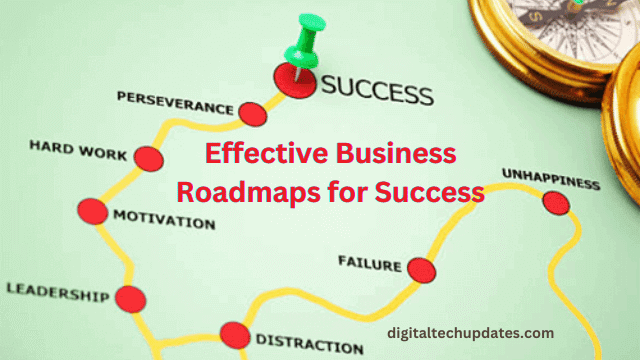Success in business hinges on more than just great ideas and products. It’s about having a clear vision and a strategic roadmap to navigate the ever-changing landscape. But what is a roadmap in business, and why is it essential?
Let’s find out.
A business roadmap is your guide to success—a blueprint that outlines your goals, resources, and the path to achieve them. Without a roadmap, businesses risk wandering aimlessly, wasting time and resources.
In this blog, we’ll dive deep into business roadmaps, addressing your pain points and providing actionable insights.
Get ready to supercharge your strategy, align your team, and drive your business to unprecedented heights.
Let’s unlock your true potential together.
What is a Business Roadmap?
A business roadmap serves as a visual representation of key elements within your business plan, all within a specified timeframe. It provides an overview of ongoing and upcoming initiatives at a high level, allowing you to assess the company’s progress toward achieving its overall goals. Picture it as a strategic blueprint that outlines the path you’ll follow to turn your long-term vision into a tangible reality.
With a business strategy roadmap, you gain a clear visualization of the necessary steps to bring your company’s vision to life and the anticipated timelines for each milestone. Whether you prefer to outline monthly, quarterly, or yearly objectives, the roadmap allows you to see the progression toward your desired outcomes.
What makes it truly valuable is its inherent flexibility, adapting to the specific needs of your business’s growth stage and the size of your team. You can determine the level of detail or abstraction that best suits your circumstances.
Importance of Having a Business Roadmap
A business roadmap is the cornerstone of a thriving enterprise, establishing a definitive path and keeping you focused on accomplishing your long-term objectives. Without a roadmap, it’s too simple to veer off course and lose sight of your ultimate vision. By providing a strategic framework, a business strategy roadmap keeps your entire team aligned and dedicated to pursuing shared goals.
A business plan roadmap helps you prioritize your initiatives and allocate resources more efficiently, ultimately leading to achieving your goals more quickly. Using a roadmap PPT template, you can visually communicate your strategic plan and progress to stakeholders, ensuring clarity and alignment. This comprehensive tool allows you to outline your path to success, anticipate potential roadblocks, and develop contingency plans to mitigate risks.
With a well-structured roadmap business plan in place, you can navigate through challenges smoothly and make informed decisions, saving valuable time and resources as you reach your desired destination.
Steps For Creating a Business Roadmap
Now that we understand what is a business roadmap and why it’s important, let’s explore the steps for creating one.
Here are four key steps:
1. Defining Your Business Vision and Goals
To initiate the creation of a business strategy roadmap, the initial task involves defining your business’s vision and goals. Your vision must encapsulate your company’s long-term aspirations, reflecting its values and mission. It serves as a statement that outlines what you aim to accomplish.
Meanwhile, your goals should adhere to the SMART criteria, meaning they need to be specific, measurable, achievable, relevant, and time-bound. By defining your vision and goals, you can ensure that your roadmap business plan supports your overall business strategy.
2. Identifying Key Milestones
The next step is identifying key milestones to help you achieve your goals. Milestones are significant achievements that mark progress toward your goals.
They can be anything from launching a new product to hiring a new team member. You can break down your goals into smaller, more manageable tasks by identifying key milestones.
3. Developing Strategies and Action Plans
This step involves identifying the needed resources, setting timelines, and assigning responsibilities.
Your strategies should align with your overall business strategy and be flexible enough to adapt to changing circumstances.
4. Assigning Tasks and Responsibilities
The last crucial phase involves delegating tasks and assigning responsibilities to your team members. It is essential to provide clear definitions for each task, ensuring that every team member comprehends what is expected of them.
By distributing tasks and responsibilities, you create a unified direction where everyone works collectively towards shared objectives. This approach guarantees that everyone understands their role and knows precisely what actions they must take to accomplish the desired outcomes.
Who can use a business roadmap?
Anyone who wants to achieve their long-term goals can use a business strategy roadmap. Whether you’re an entrepreneur, an executive manager, or a team leader, incorporating a business roadmap into your strategy empowers you to remain focused and accomplish your goals.
Business roadmaps are particularly useful for startups and small businesses still developing long-term strategies. However, larger organizations can also benefit from using a roadmap in business to ensure everyone is working towards the same goals.
Common Pitfalls to Avoid When Creating a Business Roadmap
While creating a business plan roadmap is essential to achieving your long-term goals, there are some common mistakes you should avoid.
Here are the three most common mistakes that you must watch out for:
1. Failing to Involve Key Stakeholders
One of the most common mistakes when creating a roadmap in business is failing to involve critical stakeholders in the process. This can lead to misalignment between your roadmap for business and the needs of your customers, employees, or investors.
To avoid this mistake, involve all relevant stakeholders in developing your roadmap business plan, gather their input and feedback, and ensure that their needs are addressed.
2. Being Too Ambitious or Unrealistic
Another common mistake is setting overly ambitious or unrealistic goals for your business roadmap. While it’s important to aim high and strive for success, setting achievable goals grounded in reality is essential.
Setting realistic goals can prevent disappointment and frustration and ensure that your team remains motivated and engaged throughout the process.
3. Failing to Adapt to Changing Circumstances
Finally, it’s important to remember that a business roadmap is not set in stone.
Be prepared to adapt and adjust your roadmap as needed to accommodate new information, changing market conditions, or unexpected challenges.
Ensure your business roadmap’s ongoing relevance and value by embracing flexibility and adaptability.
Wrapping It Up
A business roadmap is essential for any entrepreneur or business leader who wants to achieve their long-term goals. Crafting a precise and actionable roadmap guarantees seamless alignment within your entire team, fostering a collective effort toward shared objectives.
It is essential to engage key stakeholders, establish attainable goals, and remain adaptable in response to evolving circumstances.
With solid business templates for PowerPoint, you’ll have a clear path to success and a strong foundation for your company’s future growth.
Investing the effort into crafting a well-defined roadmap for business is a worthwhile endeavor that can propel your enterprise to extraordinary heights.




